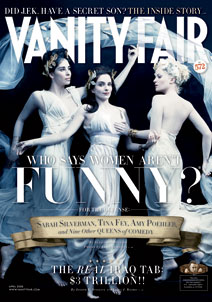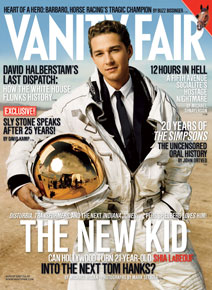 Yesterday, I wrote about my respect-recoil relationship with Vanity Fair magazine, as I felt “love-hate” was too flat to shade the nuances of my feelings about the publication. As I said then, what I detest is its racial myopia; a close focus on stories by, and about, white people. This is something basic to American media, “normal,” in certain ways, but increasingly glaring, for many reasons, at this magazine.
Yesterday, I wrote about my respect-recoil relationship with Vanity Fair magazine, as I felt “love-hate” was too flat to shade the nuances of my feelings about the publication. As I said then, what I detest is its racial myopia; a close focus on stories by, and about, white people. This is something basic to American media, “normal,” in certain ways, but increasingly glaring, for many reasons, at this magazine.
So what do I respect about Vanity Fair?
As a writer whose career has mostly been built around writing for magazines, I’m always struck by the editorial heft of Conde Nast pubs; the way good editing and design works to create an almost tactile reading experience.
I’ve said “of Conde Nast publications,” so this is their corporate quality, but Vanity Fair is the flagship. At the magazine, their features are practically oaken with the quality that substantial resources and vision can buy a publication. The writing is not only top-notch but standard-bearing; the photography is legendary. Typically, when I buy a Vanity Fair, I don’t even rush to read it. I know that the articles typically take a long view that will make good study a month, or three, or six, or a year later.
Last year, before blog—this past August, precisely—Vanity Fair ran big pieces on musical revolutionary Sly Stone and The Simpsons, both of which got covered elsewhere. (In fact, in the October issue, with the Nicole Kidman cover, VF posted a Simpsons letter-to-the-editor by this writer.)
 If you can still find a copy, however, you’ve gotta get back to that August issue and check out “Something Happened at Anne’s!”, which outlines the April 15, 2007 home invasion suffered by divorcée Anne Bass, 65, and her paramour, artist Julian Lethbridge, 59, at the couple’s 1,000-acre, South Kent CT estate.
If you can still find a copy, however, you’ve gotta get back to that August issue and check out “Something Happened at Anne’s!”, which outlines the April 15, 2007 home invasion suffered by divorcée Anne Bass, 65, and her paramour, artist Julian Lethbridge, 59, at the couple’s 1,000-acre, South Kent CT estate.
This is VF at its best. The piece is fascinating for the details of the crime, in which three yet-to-be-identified men, utilizing almost military precision, surprise, tie up, and attempt to hold the couple hostage, while demanding $8.5M in ransom at the threat of injecting them with biological agent. Yes, you read that correctly.
But what also grabs you are the nuances of How The Other Half Lives, something into which the magazine is obviously tapped. Bass, worth an estimated $200M—which, it occurs to me, means she’s broker than Jay-Z—got most of her grip divorcing billionaire investor Sid Bass in 1988. In the piece, she spends a lot of it creating her vision of a pastoral paradise, buying up bordering farms to compile her Connecticut mega-property, paying some of their owners what they deem bottom-dollar rates for the land, and pissing them off in the process. (Her boyfriend, who admits to bank accounts totaling $50,000, tops, is called “a mediocre painter” by a local. “You woke up on third base and think you hit a triple,” the man cuts, down to the marrow. “You haven’t. You [just] married a rich woman.” O.K., buddy. Just take my sword and behead me. You’ve earned it.)
Though she’d probably disagree, the writer, Michael Shnayerson, is kind to Bass. However, his portrait is unflinching. Like the worthless money-crapper that Goldie Hawn played in 1987’s Overboard, Bass talks like a robot to hired help, often referring to them in the third person as they stand nearby. This leads police to initially theorize that the holdup might have been an inside job, carried out by knowledgeable and hateful employees.
The most truly fascinating partof the piece, however, may be this exchange, when, as they try to rob her of cash, Bass tells the thieves she has no idea how to find her own bank:
“’Come on lady, don’t give me that jive.’
“’You don’t understand,’ Lethbridge said. ‘Her situation isn’t the same as yours or mine. You or I, if we get some money, we put it in the bank ourselves. Anne probably hasn’t been inside of a bank in 20 years.’
“’That’s right,’ Bass said.
“’How do you pay your bills?’the leader demanded.
“’I send them to my accountant in Texas.’”
“One attacker kept pushing the idea that Anne call her accountant in the morning and say she’d brought a property for $8 million and needed the money wired right away.
Lethbridge explained that real estate wasn’t bought that way—and if it was, the U.S. Drug Enforcement Administration would be all over the deal in a minute, sure the cash was drug money.”
Wow: It’s all in the details. At its best, Vanity Fair brings a watchmaker’s eye to storytelling, with the attention to minutiae, the passionate care, and the substantial resources needed to fully launch the reader deeply into the narrative, and into the worlds of its characters. A piece like “Something Happened at Anne’s!” is almost like great moviemaking, almost as rare, and corresponds with editor-in-chief Graydon Carter’s obvious Hollywood fascination. It’s an interest that certainly goes beyond merely selling magazines by putting starlets on the cover. It has more to do with an ear for an incredible tale. Those stories are everywhere. The magazine should look more widely for them, and tell more of them.

0 comments ↓
There are no comments yet...Kick things off by filling out the form below.
Leave a Comment